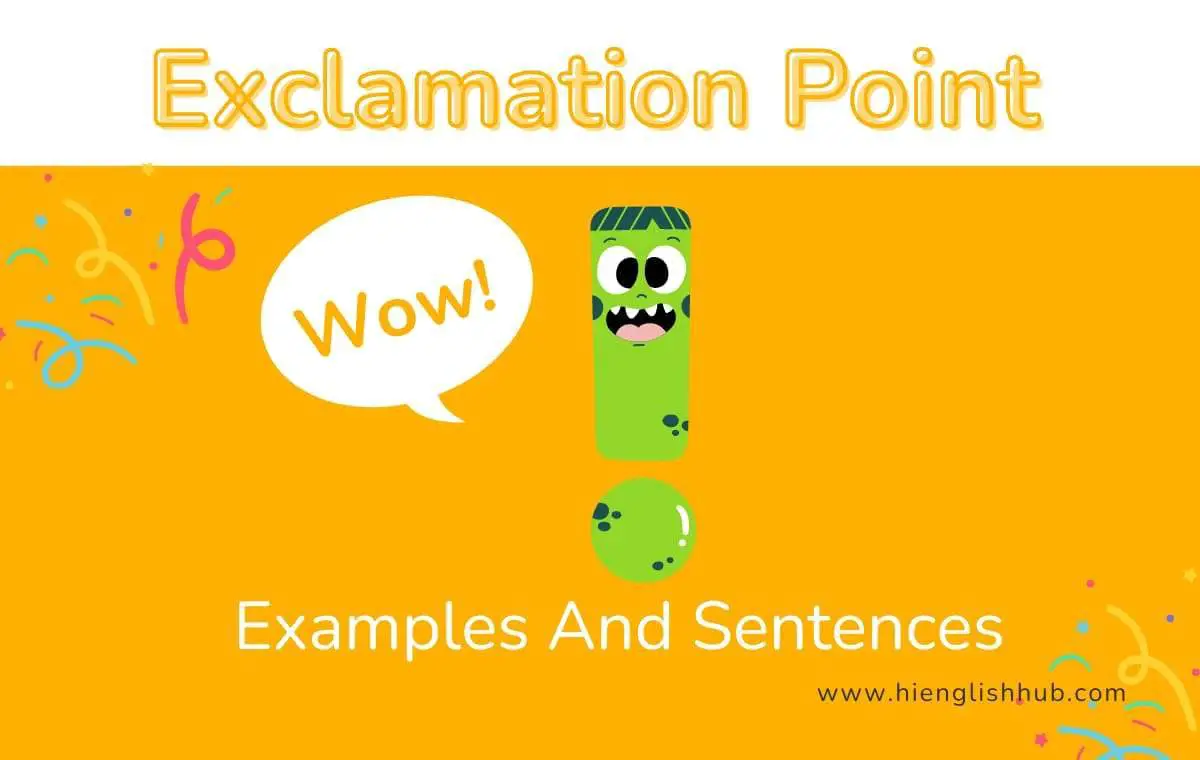You’ve probably seen this enthusiastic punctuation mark (!) quite a lot.
But here’s the question: is it called an exclamation mark or an exclamation point? Well, the answer depends on where you are!
In many parts of the English-speaking world, especially in the UK and other countries that use British English, we call it an “exclamation mark.”
Now, hop across the pond to the United States, and you’ll find people calling it an “exclamation point.”
Also read:
- What Does A Full Stop Mean?
- How To Use A Comma In A Sentence
- What Are Quotation Marks?
- What Is A Semicolon?
- Colon Usage In English: A Quick Guide
- Everything You Need To Know About Parentheses
- Apostrophe Basics & FREE Worksheet
- Ellipsis In English
- ESL Challenges: Hyphen Essentials
- Slash Secrets: Unlocking Its Writing Power
What Does An Exclamation Mark Mean?
This tiny symbol carries a lot of weight in the punctuation world.
So, what does it mean?
Well, think of it like a punctuation cheerleader or an enthusiastic friend in your sentence.
When To Use An Exclamation Mark
1. Expressing Excitement:
If you just won a game, saw an amazing movie, or got a surprise, you might use an exclamation mark to show your enthusiasm. For example: “I can’t believe we won the game!”
2. Showing Surprise:
Picture this: You walk into a room, and your friends throw you a surprise party. Surprise! That’s when the exclamation mark comes in handy. “A surprise party for me! Wow!”
3. Conveying Strong Emotions:
Sometimes, words alone can’t capture the intensity of your feelings. The exclamation mark helps convey strong emotions like joy, anger, or shock. “She said what!?”
4. Adding Emphasis:
If you want to make a point or highlight something important, the exclamation mark is your punctuation buddy. “Listen up, everyone! We have a special announcement!”
5. Indicating Commands or Warnings:
When giving a command or a warning, the exclamation mark adds a sense of urgency. “Stop! Look both ways before crossing the street!”
6. Expressing Enthusiasm in Writing:
In written communication, like emails or text messages, the exclamation mark is like adding a smile or a high-five. “Thanks for your help!”
7. Celebrating Achievements:
You can also use it to highlight accomplishments or positive outcomes. For example: “I got an A+ on my project!”
When Not To Use An Exclamation Point
While exclamation points can add emphasis and convey excitement, there are situations where it’s better to avoid using them. Here are instances when you might want to skip the exclamation point:
1. Formal Writing
In formal documents, academic papers, or professional emails, it’s often more appropriate to maintain a more neutral and serious tone. Save exclamation points for situations that truly call for excitement or emphasis.
2. Negative Statements:
Avoid using exclamation points in negative or critical statements. It can make the tone appear more confrontational. Instead, rely on the strength of your words to convey the message.
3. Overuse:
Too many exclamation points can diminish their impact. If every sentence ends with an exclamation mark, it may make your writing seem overly dramatic or insincere.
4. Routine Information:
In everyday communication or routine information sharing, such as schedules or basic updates, exclamation points may be unnecessary.
5. Professional Settings:
In a professional setting, especially in business correspondence, use exclamation points sparingly. You want to maintain a professional tone and consider alternative ways to convey enthusiasm or appreciation.
6. Warnings and Instructions:
In situations where you need to provide clear instructions or warnings, a straightforward tone without exclamation points may be more effective. They can sometimes be perceived as too casual for serious matters.
7. Serious or Sensitive Topics:
When discussing serious or sensitive topics, it’s advisable to avoid exclamation points. They might be perceived as inappropriate or lacking in empathy for the gravity of the subject matter.
Always consider the context and audience when deciding whether to include an exclamation point in your writing.
FAQs on Exclamation Point
What Are 10 Examples Of Exclamation Sentences?
- “Wow! That was an amazing performance!”
- “Ouch! I accidentally bumped my toe against the table!”
- “Yikes! I forgot to submit my homework!”
- “Bravo! You did an outstanding job on the project!”
- “Oh no! I left my phone at home!”
- “Congratulations! You’re the winner of the contest!”
- “Fantastic! We’re going on a field trip tomorrow!”
- “Help! I can’t find my keys anywhere!”
- “Incredible! The sunset is breathtaking!”
- “Oh my goodness! The baby just took her first steps!”
What Do Exclamation Marks Mean In A Text?
In a text, an exclamation mark serves several purposes:
- Expressing Excitement: “I can’t wait to see you tonight!”
- Conveying Surprise: “You won the lottery!”
- Indicating Urgency: “Call me back as soon as possible!”
- Adding Emphasis: “I absolutely love your idea!”
Are Exclamation Marks Friendly?
Yes, exclamation marks can convey a friendly and positive tone in writing. When used appropriately, they show enthusiasm, excitement, or encouragement. For example:
- “Great job on your presentation!”
- “Thanks so much for your help!”
However, it’s crucial to strike a balance and avoid excessive use, as too many exclamation marks might come across as overly enthusiastic or even insincere. A well-placed exclamation mark can add warmth and friendliness to a sentence without overwhelming the message.
How To Do An Upside-Down Exclamation Mark On Mac
To type an upside-down exclamation mark (¡) on a Mac, you can use the following keyboard shortcut:
- Hold down the “Option” key on your keyboard.
- While holding down the “Option” key, press the “1” key.


